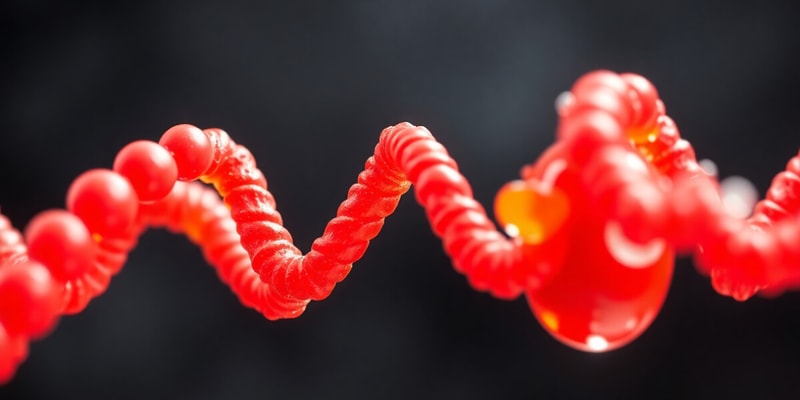Podcast
Questions and Answers
Which factor is primarily responsible for determining whether a spontaneous process occurs?
Which factor is primarily responsible for determining whether a spontaneous process occurs?
What is the condition for a spontaneous reaction to occur at constant temperature and pressure?
What is the condition for a spontaneous reaction to occur at constant temperature and pressure?
Why does heat transfer from a hot object to a cold one occur spontaneously?
Why does heat transfer from a hot object to a cold one occur spontaneously?
Which of the following processes typically does not occur spontaneously?
Which of the following processes typically does not occur spontaneously?
Signup and view all the answers
What does a positive change in entropy (ΔS) suggest about a process?
What does a positive change in entropy (ΔS) suggest about a process?
Signup and view all the answers
Which statement is true regarding exothermic processes and spontaneity?
Which statement is true regarding exothermic processes and spontaneity?
Signup and view all the answers
How does entropy (ΔS) influence the spontaneity of a process involving gas mixing?
How does entropy (ΔS) influence the spontaneity of a process involving gas mixing?
Signup and view all the answers
In which situation would a change in enthalpy (ΔH) not accurately predict reaction spontaneity?
In which situation would a change in enthalpy (ΔH) not accurately predict reaction spontaneity?
Signup and view all the answers
What does a positive change in entropy during an irreversible heat transfer signify?
What does a positive change in entropy during an irreversible heat transfer signify?
Signup and view all the answers
Which statement best describes the Second Law of Thermodynamics?
Which statement best describes the Second Law of Thermodynamics?
Signup and view all the answers
Which of the following statements about reversible processes is true?
Which of the following statements about reversible processes is true?
Signup and view all the answers
What characteristic distinguishes irreversible processes from reversible processes?
What characteristic distinguishes irreversible processes from reversible processes?
Signup and view all the answers
Why is it stated that no process can be perfectly reversible?
Why is it stated that no process can be perfectly reversible?
Signup and view all the answers
What must be true for a process to be classified as spontaneous regarding entropy?
What must be true for a process to be classified as spontaneous regarding entropy?
Signup and view all the answers
Which statement about entropy as a state function is correct?
Which statement about entropy as a state function is correct?
Signup and view all the answers
How does the Second Law of Thermodynamics relate to spontaneous processes?
How does the Second Law of Thermodynamics relate to spontaneous processes?
Signup and view all the answers
At what temperature does the entropy of a perfectly ordered crystal become zero?
At what temperature does the entropy of a perfectly ordered crystal become zero?
Signup and view all the answers
What happens to entropy as temperature increases from absolute zero?
What happens to entropy as temperature increases from absolute zero?
Signup and view all the answers
What happens to entropy as temperature decreases?
What happens to entropy as temperature decreases?
Signup and view all the answers
What characterizes a system at equilibrium in terms of entropy?
What characterizes a system at equilibrium in terms of entropy?
Signup and view all the answers
During phase transitions, what occurs to the entropy of a substance?
During phase transitions, what occurs to the entropy of a substance?
Signup and view all the answers
Which of the following best describes the relationship between entropy and the direction of a process?
Which of the following best describes the relationship between entropy and the direction of a process?
Signup and view all the answers
At absolute zero, the entropy of a perfect crystal is theoretically what?
At absolute zero, the entropy of a perfect crystal is theoretically what?
Signup and view all the answers
Which concept aligns with the statement: 'Entropy is a measure of disorder in a system'?
Which concept aligns with the statement: 'Entropy is a measure of disorder in a system'?
Signup and view all the answers
In what type of process is the total change in entropy typically negative?
In what type of process is the total change in entropy typically negative?
Signup and view all the answers
What can be said about entropy when considering it as a thermodynamic state function?
What can be said about entropy when considering it as a thermodynamic state function?
Signup and view all the answers
How does enthalpy (H) relate to entropy (S) as a thermodynamic state function?
How does enthalpy (H) relate to entropy (S) as a thermodynamic state function?
Signup and view all the answers
How does entropy behave within a single phase as temperature rises?
How does entropy behave within a single phase as temperature rises?
Signup and view all the answers
What characterizes large drops in entropy during phase transitions?
What characterizes large drops in entropy during phase transitions?
Signup and view all the answers
What principle can be inferred about calculating changes in entropy (ΔS) during a process?
What principle can be inferred about calculating changes in entropy (ΔS) during a process?
Signup and view all the answers
In what scenario would the order of a system significantly increase?
In what scenario would the order of a system significantly increase?
Signup and view all the answers
As temperature decreases gradually within a phase, what trend is observed in terms of molecular motion?
As temperature decreases gradually within a phase, what trend is observed in terms of molecular motion?
Signup and view all the answers
What does the intensity factor represent in mechanical energy systems?
What does the intensity factor represent in mechanical energy systems?
Signup and view all the answers
In the context of pressure-volume work, what does the capacity factor denote?
In the context of pressure-volume work, what does the capacity factor denote?
Signup and view all the answers
Which statement accurately describes the relationship between temperature and heat transfer?
Which statement accurately describes the relationship between temperature and heat transfer?
Signup and view all the answers
Which of the following correctly defines electrical energy in terms of its intensity and capacity factors?
Which of the following correctly defines electrical energy in terms of its intensity and capacity factors?
Signup and view all the answers
What does entropy represent in the intensity-capacity framework of thermodynamics?
What does entropy represent in the intensity-capacity framework of thermodynamics?
Signup and view all the answers
In mechanical energy, how is energy quantitatively expressed?
In mechanical energy, how is energy quantitatively expressed?
Signup and view all the answers
Which of the following pairs correctly identifies the intensity and capacity factors for electrical energy?
Which of the following pairs correctly identifies the intensity and capacity factors for electrical energy?
Signup and view all the answers
How can the energy transfer due to heat be mathematically expressed?
How can the energy transfer due to heat be mathematically expressed?
Signup and view all the answers
In thermodynamic systems, what role does pressure play as an intensity factor?
In thermodynamic systems, what role does pressure play as an intensity factor?
Signup and view all the answers
Which of the following correctly summarizes the concept of intensity and capacity factors in energy systems?
Which of the following correctly summarizes the concept of intensity and capacity factors in energy systems?
Signup and view all the answers
Study Notes
The Direction of Spontaneous Change
- Spontaneity is a natural tendency for systems to move toward higher entropy (greater disorder) or to release energy.
- The first law of thermodynamics focuses on energy conservation and doesn't reveal the direction of a reaction.
-
Enthalpy (ΔH) indicates whether a process absorbs or releases energy.
- Exothermic processes (negative ΔH) release energy, often spontaneous, but not always.
-
Entropy (ΔS) measures disorder or randomness in a system.
- A positive ΔS indicates increased disorder, often associated with spontaneity.
-
Gibbs Free Energy (ΔG) combines enthalpy and entropy to predict spontaneity.
- Negative ΔG at constant temperature and pressure indicates a spontaneous process.
Spontaneous Processes
- Spontaneous processes occur naturally without external intervention.
- Heat transfer from a hot object to a cold one increases entropy, as energy disperses.
- Gas mixing leads to an increase in entropy as molecules randomly distribute across available volume.
Entropy as a State Function
- Entropy (S) is a thermodynamic state function, its value depends on the system's state, not the path taken.
- Change in entropy (ΔS) tells us about the direction of a process.
- Spontaneous processes generally increase the total entropy of the system and its surroundings (ΔStotal>0).
- For a process to be spontaneous, ΔSuniverse (the entropy of the universe) must be positive.
Entropy and Equilibrium
- Entropy is maximized at equilibrium meaning no net change and the system is stable.
- At equilibrium, there is no preferred direction of change.
Entropy vs. Temperature
- The third law of thermodynamics states that the entropy of a perfectly ordered crystal is zero (S=0) at absolute zero (0 K).
- Entropy increases as temperature increases because particles gain energy and their motion becomes less ordered.
- Entropy decreases as temperature decreases because particles slow down, leading to increased order.
-
Phase transitions (solid to liquid, liquid to gas) involve significant changes in entropy.
- Increased freedom of movement in a new phase leads to a sharp rise in entropy.
- For example, entropy increases when ice melts to water.
- Entropy increases within a single phase as temperature rises.
- Entropy is a state function, therefore changes are path-independent, relying on the initial and final states.
Energy, Temperature, Heat, and Entropy
- Energy can be understood through intensity and capacity factors.
- Intensity factors are driving forces, while capacity factors represent the extent of the force's action.
-
Heat is related to temperature through intensity and capacity factors.
- Temperature is the intensity factor, driving heat transfer.
- Entropy (S) is the capacity factor, representing the extent or "amount" of heat energy at a given temperature.
Heat Transfer and Entropy
- Reversible heat transfer implies no net increase in entropy of the universe, as the entropy changes of the system and surroundings are equal.
- Irreversible heat transfer results in a net increase in the entropy of the universe as energy is dispersed and cannot be fully recovered.
The Second Law of Thermodynamics
- The second law of thermodynamics states that the entropy of the universe always increases in any spontaneous process.
- Spontaneous processes are associated with a net increase in entropy.
- Reversible processes involve no net increase in entropy of the universe.
- Irreversible processes result in a positive increase in entropy.
- There are no perfectly reversible processes in nature.
Studying That Suits You
Use AI to generate personalized quizzes and flashcards to suit your learning preferences.
Related Documents
Description
This quiz explores fundamental concepts in thermodynamics, focusing on spontaneity, Gibbs Free Energy, and changes in entropy and enthalpy. Understand how these principles determine whether a process occurs naturally and how energy is conserved or transformed in spontaneous processes.




